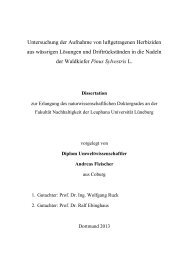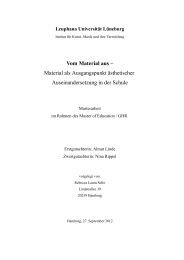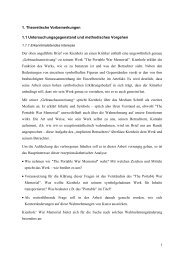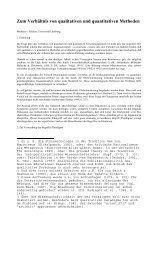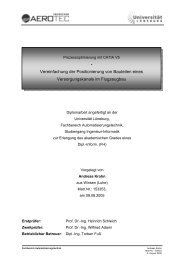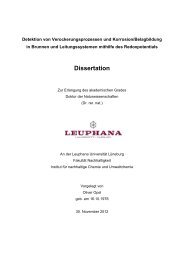Determinants of Emotional Experiences in Traffic Situations ... - OPUS
Determinants of Emotional Experiences in Traffic Situations ... - OPUS
Determinants of Emotional Experiences in Traffic Situations ... - OPUS
Create successful ePaper yourself
Turn your PDF publications into a flip-book with our unique Google optimized e-Paper software.
84 <strong>Emotional</strong> States <strong>of</strong> Drivers and Their Impact on Driv<strong>in</strong>g Behaviour!<br />
Fright Wald χ 2 Sig. CI (95%)<br />
AIC/df 2.817<br />
!<br />
BIC/df 3.014<br />
!<br />
Likelihood χ2 1.305 .806<br />
!<br />
!<br />
!<br />
! Constant ! ! 8.28 .086 ! 0.06 ! 2.944<br />
Gender 1.57 .430 0.645 0.622<br />
Mileage 1.31 .404 3.30E-01 0.696<br />
Driv<strong>in</strong>g Motivation 0.91 .311 0.121 1.025<br />
STAI 0.14 -950 0.205 0.004<br />
Gender was coded with female = 0, male = 1<br />
Bold χ 2 -Values are significant at p < .05<br />
! !<br />
! !<br />
3.3.4 Emotions and Driv<strong>in</strong>g Behaviour<br />
In the next step, the self-reported emotions were related to the driv<strong>in</strong>g parameters <strong>of</strong> the participant by<br />
employ<strong>in</strong>g a multiple l<strong>in</strong>ear regression. As <strong>in</strong>dependent variables, the experienced emotion <strong>of</strong> <strong>in</strong>terest,<br />
the emotion from the same doma<strong>in</strong> (anger with contempt / anxiety with fright; all dichotomized at the<br />
median), gender, driv<strong>in</strong>g experience, driv<strong>in</strong>g motivation and the associated trait-emotion-questionnaire<br />
(DAS for anger and contempt / STAI for anxiety and fright) were <strong>in</strong>serted. The dependent variables<br />
were the specific longitud<strong>in</strong>al and lateral driv<strong>in</strong>g parameters: scenario 1-3 focussed on acceleration<br />
(m/s 2 ) directly after the imped<strong>in</strong>g event (slow car, construction site, brak<strong>in</strong>g car) and those values were<br />
summed up. Scenario 4 focussed on the strength <strong>of</strong> brak<strong>in</strong>g (m/s 2 ) after the confrontation with the<br />
obstacle. In all scenarios, the impact <strong>of</strong> the emotions on the velocity (km/h) and lateral acceleration<br />
(m/s 2 ) directly after the event and <strong>in</strong> the neutral zone were evaluated. Speed<strong>in</strong>g behaviour was only<br />
analysed <strong>in</strong> the neutral zone because the critical event forced the participants to slow down <strong>in</strong> the first<br />
place. Two time frames were analysed: the first 500m after the critical event (t1) and a subsequent<br />
neutral zone, which consisted <strong>of</strong> several road sections with an overall length <strong>of</strong> 2000m (t2). To<br />
account for the high correlations between driv<strong>in</strong>g patterns directly after the event and <strong>in</strong> the neutral<br />
zone multiple regressions were employed: (1) with the complete set <strong>of</strong> predictors and the driv<strong>in</strong>g<br />
<strong>in</strong>dicator at t1 as dependent variable and (2) with the same set <strong>of</strong> predictors (<strong>in</strong>clud<strong>in</strong>g t1) and t2 as<br />
dependent variable. As the results <strong>in</strong>dicate, anger, contempt, anxiety and fright had an effect dur<strong>in</strong>g<br />
the experiment (Figure 3, 4 and 5).<br />
People who experienced more anger drove faster (standardized coefficient β = .28, t(73;6) =<br />
2.71, p< .009) directly after the event (Figure 3 and 4). But heightened anger did not expla<strong>in</strong> additional<br />
variances <strong>of</strong> speed <strong>in</strong> the neutral zone (β = .08, t(73;6) = 0.94, n.s.) and previous velocity was the<br />
strongest predictor here (β = .72, t(73;6) = 9.15, p< .001). The same pattern <strong>of</strong> <strong>in</strong>fluence was true for<br />
acceleration: higher anger scores lead to stronger acceleration directly after the event (β = .27, t(73;6)<br />
= 2.28, p< .023), but not necessarily dur<strong>in</strong>g t2 (β = .18, t(73;6) = 1.12, n.s.). Lateral acceleration was



